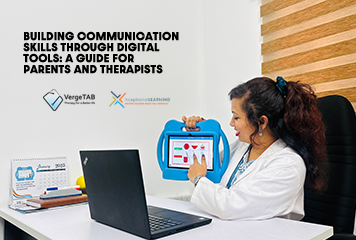Building Communication Skills through Digital Tools: A Guide for Parents and Therapists
23 Apr 2025

Communication is essential for a child’s cognitive, emotional, and social growth. For those with speech delays, autism, or developmental challenges, building these skills can be complex. Traditionally, speech therapy relied on in-person sessions, but digital tools have transformed the process. Today, parents and therapists can use speech therapy apps, assistive devices, digital activity books, and AI-powered platforms to make learning engaging and personalized. These tools enhance speech, language, and social communication, reshaping how children develop essential skills. This guide explores their impact and how to integrate them effectively.
Benefits of Digital Tools for Communication Development
- Enhancing Engagement and Motivation – Gamification, interactive visuals, and instant feedback make therapy sessions more engaging and enjoyable for children.
- Personalized Learning Experiences – Customized exercises cater to individual needs, ensuring targeted intervention based on progress.
- Accessible Anytime, Anywhere – Digital tools can be used on tablets, smartphones, and computers, offering flexibility for parents and therapists.
- Data Tracking and Progress Monitoring – Analytics and reports help track a child’s progress, enabling data-driven therapy decisions.
- Integration with Traditional Therapy – Digital tools complement traditional speech therapy by reinforcing learned skills through interactive exercises.
Best Digital Tools for Communication Development
1. XL Platform – A Comprehensive Therapy Solution
XL Platform is an advanced digital therapy solution designed to support communication development in children. It offers a structured and personalized approach to therapy with features such as:
- Live virtual therapy sessions with certified speech and language therapists.
- Progress tracking and assessment tools that help monitor improvements over time.
- Customizable therapy plans are tailored to each child’s unique speech and language needs.
- Interactive exercises and digital activities that make learning more engaging and effective.
- Parent and therapist collaboration tools to ensure a seamless learning experience at home and during therapy sessions.
This platform bridges the gap between traditional and digital therapy, making it easier for children to receive consistent and high-quality speech therapy support.
2. Digital Activity Book – Fun and Engaging Therapy at Home
Digital Activity Book is a powerful tool for enhancing speech, language, and communication skills through interactive exercises. It includes:
- Engaging visuals and animations that capture a child’s attention and make learning fun.
- Gamified activities that encourage participation and motivation.
- Speech and language exercises targeting vocabulary, articulation, and comprehension.
- Customizable learning paths based on a child’s needs and progress.
- Therapist-approved content ensures effectiveness in communication development.
This tool allows parents to reinforce therapy at home while making the learning process enjoyable for children.
How Parents Can Use Digital Tools at Home
- Make Learning Part of Daily Activities – Integrate digital speech therapy tools into everyday moments like storytelling, singing, or interactive games.
- Encourage Creative Expression – Use drawing apps, digital storytelling platforms, or voice recording tools to help children build language and communication skills.
- Engage in Virtual Speech Exercises – Interactive AI-based programs can help children practice pronunciation, sentence formation, and social conversations.
- Track Progress with Digital Reports – Many apps provide progress tracking, allowing parents to monitor improvements and adjust activities accordingly.
- Support Communication with Assistive Tools – AAC devices and digital communication boards help children with speech difficulties express their thoughts effectively.
How Therapists Can Integrate Digital Tools into Therapy
- Assess Individual Needs – Identify each child’s communication challenges and select appropriate digital tools to address their specific needs.
- Combine Traditional and Digital Methods – Integrate digital tools alongside traditional therapy techniques for a balanced approach.
- Monitor Progress with AI-Powered Analytics – Use therapy platforms that provide detailed reports to track progress and refine treatment strategies.
- Encourage Parent Involvement – Guide parents on incorporating digital tools at home to support ongoing therapy.
- Utilize Virtual Therapy for Remote Access – Conduct online therapy sessions through platforms like XceptionalLEARNING to reach children in various locations.
Overcoming Challenges in Using Digital Tools
Managing Screen Time
- Challenge: Excessive screen time reduces physical activity and social interaction.
- Solution: Balance digital learning with outdoor play. XL Platform’s screen time management helps regulate usage.
Ensuring Engagement
- Challenge: Some children struggle to stay engaged.
- Solution: Use gamified activities, rewards, and personalized content on the XL Platform to boost motivation.
Choosing the Right Device
- Challenge: Not all devices support speech therapy.
- Solution: VergeTAB offers touchscreen accessibility, high-quality audio, and seamless therapy sessions.
Addressing Technical Issues
- Challenge: Internet or software issues can disrupt therapy.
- Solution: Use a stable connection and XL Platform’s offline resources for uninterrupted learning.
Encouraging Parental Involvement
- Challenge: Some parents struggle with digital tools.
- Solution: XL Platform offers training modules and therapist guidance for home integration.
Ensuring Personalized Learning
- Challenge: One-size-fits-all approaches may not work.
- Solution: XL Platform’s customizable therapy plans adapt to each child’s needs.
Maintaining Consistency
- Challenge: Irregular practice slows progress.
- Solution: XL Platform’s tracking and reminders ensure regular learning at home.
Future of Digital Tools in Communication Development
- Virtual Reality Speech Therapy – Immersive experiences to enhance language learning.
- AI-Powered Personalized Therapy – Advanced algorithms to provide real-time feedback and customized therapy plans.
- Gesture-Based Communication Systems – Non-verbal communication tools using motion sensors.
- Brain-Computer Interface (BCI) – Enables communication using neural signals for individuals with severe speech impairments.
- Haptic Feedback Devices – Wearables that enhance speech training through tactile reinforcement of articulation.
In Conclusion, Digital tools have transformed how parents and therapists support communication development in children. From speech therapy apps to AI-powered solutions and AAC devices, these tools make learning more engaging, accessible, and effective. Parents can integrate these tools into daily routines, while therapists can use them to enhance therapy sessions. Platforms like XceptionalLEARNING and devices like VergeTAB are revolutionizing speech and language therapy, ensuring children receive personalized and effective support. With the integration of hybrid model therapy, which combines in-person and digital interventions, children receive comprehensive care tailored to their needs. Contact us at +91 8921287775 today for a free demo and explore how our approach supports your child’s development.


